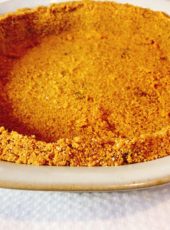Whatever the regional flair, a seafood boil is as much about the event as it is about the food. Nothing says summer in the South quite like this one.
“Every port city has a great seafood one-pot.” – Chef Steven Satterfield
Rhoda Boone, writing for Epicurious, explains the various one-pot seafood meals along American coastal cities and towns, “Where there’s American coastline, there’s a regional seafood boil, whether you’re talking about the clam bakes of New England, the crab boils of Maryland, the whitefish boils of the Great Lakes, or the crawfish boils of Louisiana. Most combine fresh catches of shellfish with local seasonings for a festive one-pot feast fit for a crowd.”
Those are the key ingredients: fresh seafood, seasonings, vegetables, and a hungry crowd. As Boone also notes in her article, seafood boils are a “joyous occasion.” While the food is delicious, it’s more about the event, the process, and the camaraderie of taking part in a seasonal – and regional – happening. You know you’re in New England if you’re at a clambake, and likely you’re celebrating one of the holidays that sandwiches summer – Memorial Day or Labor Day.
Foodicles explains that the Clambake can be traced to Native American cooking methods from more than 2000 years ago. They made use of the plentiful seafood around them and the earth below them, cooking fresh catches at the coastline, covered in sand and seaweed. Eventually the new Europeans learned the tradition from them and popularized it as their own, writing that it was a new American tradition. This is one of those ways that food history tells you a little something about the wider cultural history.

Folks who follow this history seem to believe it was the first American seafood boil of its kind, noting that as people moved south and west, they adapted to the new seafood of the region and added pots to the equation. Others claim the history of the seafood boil can be traced through the Cajun crawfish boils in Louisiana to the Acadian Exile that displaced Maritime Canadians into Southern Louisiana.
Both of these versions make sense, but I’m also partial to the story that the seafood boil has roots in the low country of the Southeastern United States, linked to the traditions of the Gullah-Geechee people. According to Southern Kitchen, the Gullah-Geechee are direct descendants of the first enslaved Africans to arrive on U.S. soil. They can trace their lineage through the transatlantic slave trade from Sierra Leone and other West African nations. Residing along the Sea Islands and low country of the coasts of Georgia and South Carolina, they are less assimilated and more insulated than any other descendants of the African diaspora. This means their culture, language, and food has been kept miraculously intact.
Chef Benjamin Dennis is an acclaimed chef and member of this community, involved in preserving and promoting their culture. In conversation with Old Ways Non-Profit, he says, “We [Gullah-Geechee] people say we are descendants of the Gullah people. Pure Gullah [language] is basically Africanisms and African dialect. Geechee is the English derivative, what we say is slang. You can hear the Gullah language and Gullah cadence in the way we speak in Geechee. As far as the foodways there’s no difference.” Simultaneously a chef and educator, he works to credit his people with the American food traditions we take for granted. Afar Magazine quotes Dennis, “[The Gullah-Geechee people are responsible for] a lot of the basis not only of South Carolina food, but Southern food, and the original food culture of the New World.”

Charleston Magazine accounts for two origin stories. After the traditional influences of the Gullah-Geechee cooking methods, the modern popularity stems from Robert Gay’s 1960’s resurrection of an old family recipe to feed 100 National Guardsman in a hurry. His family’s restaurant is Frogmore, near Beaufort, South Carolina, which is why the boil is sometimes called “Frogmore Stew” or “Beaufort Stew.” Gourmet Magazine featured a photo of his recipe on a 1980’s cover and the dish received more national notoriety.
As Foodicles points out, one-pot seafood dishes might be boiled or steamed, baked, or raw, but they all tend to include sausage, potatoes, and corn. There’s no real wrong way to do it, so long as you add ingredients at different intervals to avoid overcooking and you add enough spices. And as, Chef Steven Satterfield advises, another crucial part is the beer you drink while it cooks.
Low Country Boil
Recipe by Trisha Yearwood @Food NetworkCourse: MainDifficulty: Easy8-10
servings15
minutes35
minutesIngredients
1/2 cup concentrated Louisiana-style shrimp and crab boil seasoning (such as Zatarain's)
4 pounds medium red potatoes
2 to 3 medium sweet onions, such as Vidalia, peeled and quartered if large
2 1/2 pounds andouille sausage, cut into 3-inch pieces
8 ears of corn, cut into thirds
4 pounds medium shrimp, deveined, cleaned, with shells on
melted butter, lemon wedges, and cocktail sauce for serving
Directions
- Fill a 7-gallon stockpot halfway with water (or use 2 large pots and divide the ingredients between them). Add the seasoning and bring to a rolling boil. Add the whole potatoes to the pot. Allow the water to return to a boil and cook 5 minutes. Add the onions and sausage. Bring the water back to a boil and cook 15 minutes. Add the corn, bring the water back to a boil and cook 10 minutes, or until the potatoes are done.
- Add the shrimp, bring the water back to a boil and cook until the shrimp turn pink, about 3 minutes. Drain through a colander; discard the liquid. Serve on newspaper or brown butcher's paper.





